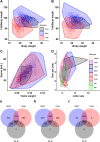Phenogenomic resources immortalized in a panel of wild-derived strains of five species of house mice
- PMID: 40199997
- PMCID: PMC11978780
- DOI: 10.1038/s41598-025-86505-x
Phenogenomic resources immortalized in a panel of wild-derived strains of five species of house mice
Abstract
The house mouse, Mus musculus, is a widely used animal model in biomedical research, with classical laboratory strains (CLS) being the most frequently employed. However, the limited genetic variability in CLS hinders their applicability in evolutionary studies. Wild-derived strains (WDS), on the other hand, provide a suitable resource for such investigations. This study quantifies genetic and phenotypic data of 101 WDS representing 5 species, 3 subspecies, and 8 natural Y consomic strains and compares them with CLS. Genetic variability was estimated using whole mtDNA sequences, the Prdm9 gene, and copy number variation at two sex chromosome-linked genes. WDS exhibit a large natural variation with up to 2173 polymorphic sites in mitogenomes, whereas CLS display 92 sites. Moreover, while CLS have two Prdm9 alleles, WDS harbour 46 different alleles. Although CLS resemble M. m. domesticus and M. m. musculus WDS, they differ from them in 10 and 14 out of 16 phenotypic traits, respectively. The results suggest that WDS can be a useful tool in evolutionary and biomedical studies with great potential for medical applications.
© 2025. The Author(s).
Conflict of interest statement
Declarations. Competing interests: The authors declare no competing interests.
Figures






Similar articles
-
Diversity of Prdm9 zinc finger array in wild mice unravels new facets of the evolutionary turnover of this coding minisatellite.PLoS One. 2014 Jan 13;9(1):e85021. doi: 10.1371/journal.pone.0085021. eCollection 2014. PLoS One. 2014. PMID: 24454780 Free PMC article.
-
Prdm9 Intersubspecific Interactions in Hybrid Male Sterility of House Mouse.Mol Biol Evol. 2020 Dec 16;37(12):3423-3438. doi: 10.1093/molbev/msaa167. Mol Biol Evol. 2020. PMID: 32642764 Free PMC article.
-
Endogenous gammaretrovirus acquisition in Mus musculus subspecies carrying functional variants of the XPR1 virus receptor.J Virol. 2013 Sep;87(17):9845-55. doi: 10.1128/JVI.01264-13. Epub 2013 Jul 3. J Virol. 2013. PMID: 23824809 Free PMC article.
-
PWD/Ph and PWK/Ph inbred mouse strains of Mus m. musculus subspecies--a valuable resource of phenotypic variations and genomic polymorphisms.Folia Biol (Praha). 2000;46(1):31-41. Folia Biol (Praha). 2000. PMID: 10730880 Review.
-
Wild-derived mice: from genetic diversity to variation in immune responses.Mamm Genome. 2018 Aug;29(7-8):577-584. doi: 10.1007/s00335-018-9766-3. Epub 2018 Jul 28. Mamm Genome. 2018. PMID: 30056578 Free PMC article. Review.
References
-
- Yamaguchi, M. & Yoshida, H. in In Drosophila Models for Human Diseases (eds Yamaguchi, M.) 1–10 (Springer, 2018).
-
- Morgan, T. H., Sturtevant, A. H., Muller, H. J. & Bridges, C. B. The Mechanisms of Mendelian Heredity (Henry Holt & Co., 1915).
-
- Fox, J. G. et al. The Mouse in Biomedical Research. Vol. 1. History, Wild Mice, and Genetics (Elsevier, 2007).
-
- Fox, J. G. et al. The Mouse in Biomedical Research. Vol. 3. Normative Biology, Husbandry, and Models (Elsevier, 2007).
MeSH terms
Substances
LinkOut - more resources
Full Text Sources

